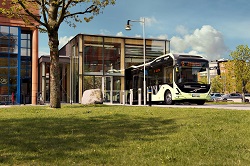The bus of the future
By 2050, two thirds of the world’s population will live in cities. Finding ways to improve mobility for these people has therefore become a priority. Studies show that the most efficient way to travel in densely populated areas in terms of urban space and energy consumption is by public transport. The EU-funded EBSF_2 project is a Horizon 2020 initiative coordinated by the International Association of Public Transport (UITP). Building on the work of the previous EBSF initiative, it combined the efforts of 42 European stakeholders, enhancing the efficiency and reliability of urban bus transport, and raising the profile of the bus among users. Researchers and bus stakeholders assessed the viability of a range of innovative technologies and their application to more than 200 vehicles operating in 12 European bus networks. “We identified six research areas with the highest potential for producing ground-breaking changes in bus transport and studied the requirements of vehicles, infrastructures and operations together with the needs of passengers, operators, drivers, and manufacturers,” says project coordinator Michele Tozzi. Greater energy efficiency The consortium successfully tested technologies that reduce energy demand by approximately 15 – 60 % in heating, ventilation and air conditioning systems for electric buses under different climate and operating conditions. “Several advanced solutions for improved energy efficiency in bus systems have been tested and validated, mainly under real-life conditions. The most successful ones will shortly be put into production,” Tozzi explains. The project also examined the benefits of ecodriving, an efficient way of driving that emphasises fuel efficiency, comfort and safety for diesel, hybrid and electric buses. In Barcelona, for instance, over 80 % of bus drivers found that the green driver assistance system helped to minimise abrupt starts and stops, which have been cut to below 50 % since the pilot was implemented. Based on an extensive literature survey and the analysis of the EBSF_2 results of different green driver assistance systems, the project also proposed guidelines for the design of the human-machine interface for ecodriving. IT solutions Demonstrators explored new algorithms and tools for predictive maintenance (like new filters and quality sensors for the engine oil), autonomous parking procedures and open IT standard protocols for telediagnostic systems to monitor heterogeneous fleets remotely. “Innovative maintenance procedures in synergy with standardised IT architecture can improve information availability and precision. This can reduce maintenance costs and the occurrence of breakdowns, as well as extending the life of components and engine oil,” claims Tozzi. In addition, in London EBSF_2 tested the implementation and operation of on-board bus equipment from multiple suppliers reporting to the same back-office suite in an existing bus fleet. Open interfaces provided cost-effective interoperability with different automated vehicle location systems and back-office service control systems. On 1 March 2018, the EBSF_2 London Demonstrator won the Most Innovative Transport Project Award. According to Tozzi: “The knowledge gained from the technical implementations performed within EBSF_2 was shared with standardisation groups to support the deployment of standards for onboard plug-and-play IT-systems for public transport.” Vehicle simulations Project partners also used simulations of internal vehicle layouts to improve passenger flow and accessibility for all. Results of simulations and field trials indicated that electric buses have great potential to influence comfort, safety, and accessibility. Silent and zero local emissions electric buses offer new possibilities for integrating public transport into the urban environment by harmonising vehicle layout and bus stop design. In Gothenburg, Sweden, project partners demonstrated the feasibility and potential of an ‘indoor’ bus stop, which provides a cosy-looking interior and shelter from the weather. This means that a specific destination like a library, a hospital, or a shopping mall could in the future act as a bus stop. EBSF_2 successfully combined research with demonstrators based on innovative technologies to provide intelligent, cost-effective, energy-efficient and customer-oriented bus systems for greater mobility in Europe’s cities. “The project answers the need for cleaner and more efficient buses by validating innovative technological solutions as well as developing concepts, guidelines and standards to be adopted in tenders for bus fleet renewal,” Tozzi concludes.
Keywords
EBSF_2, bus, public transport, fleet, demonstrator, IT system







